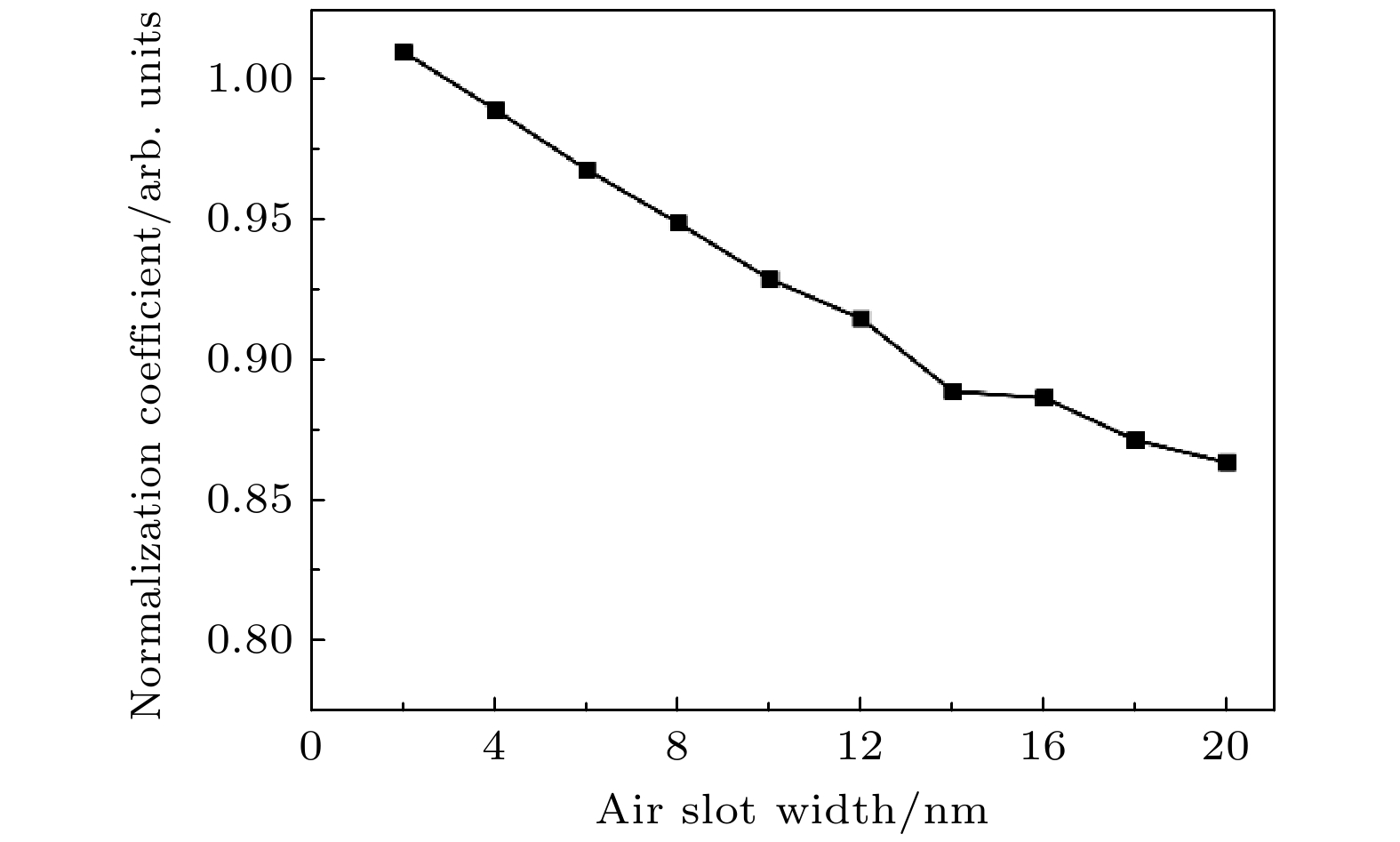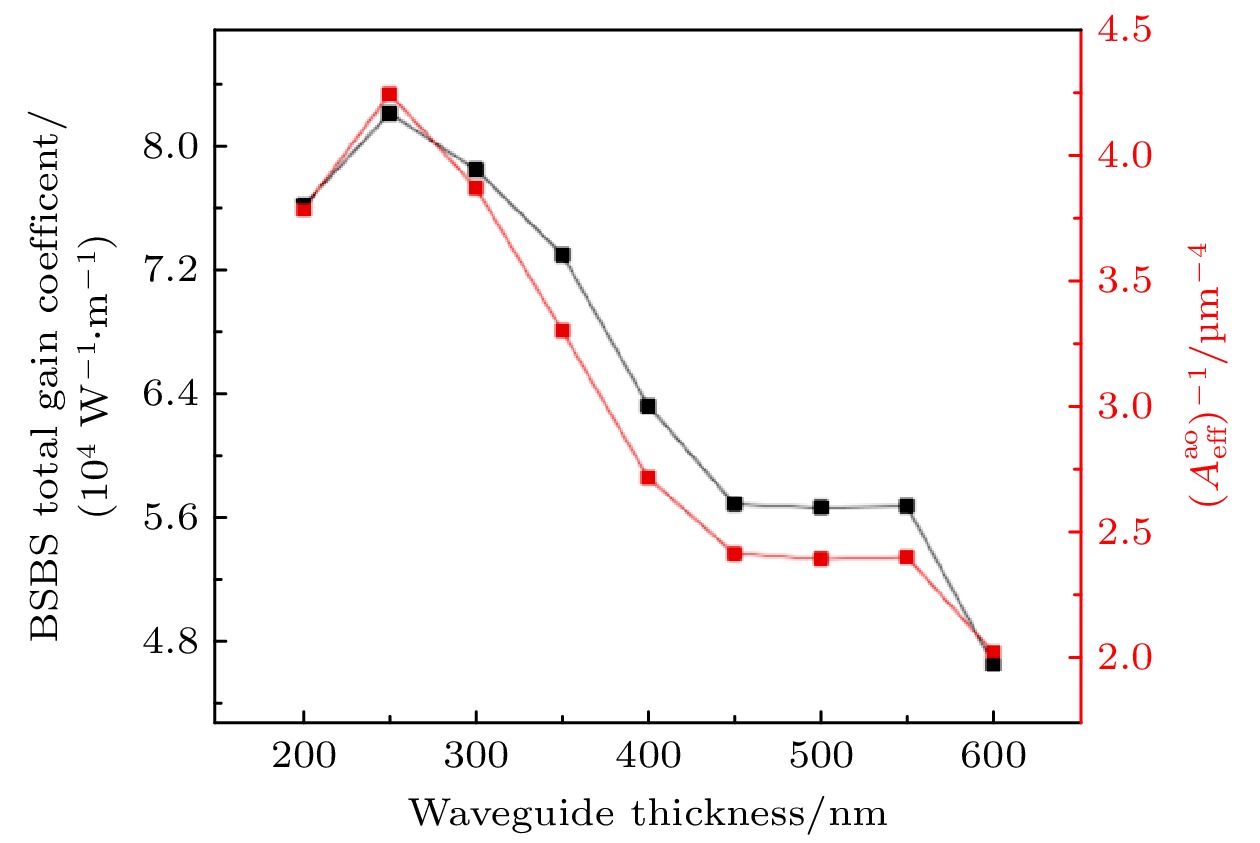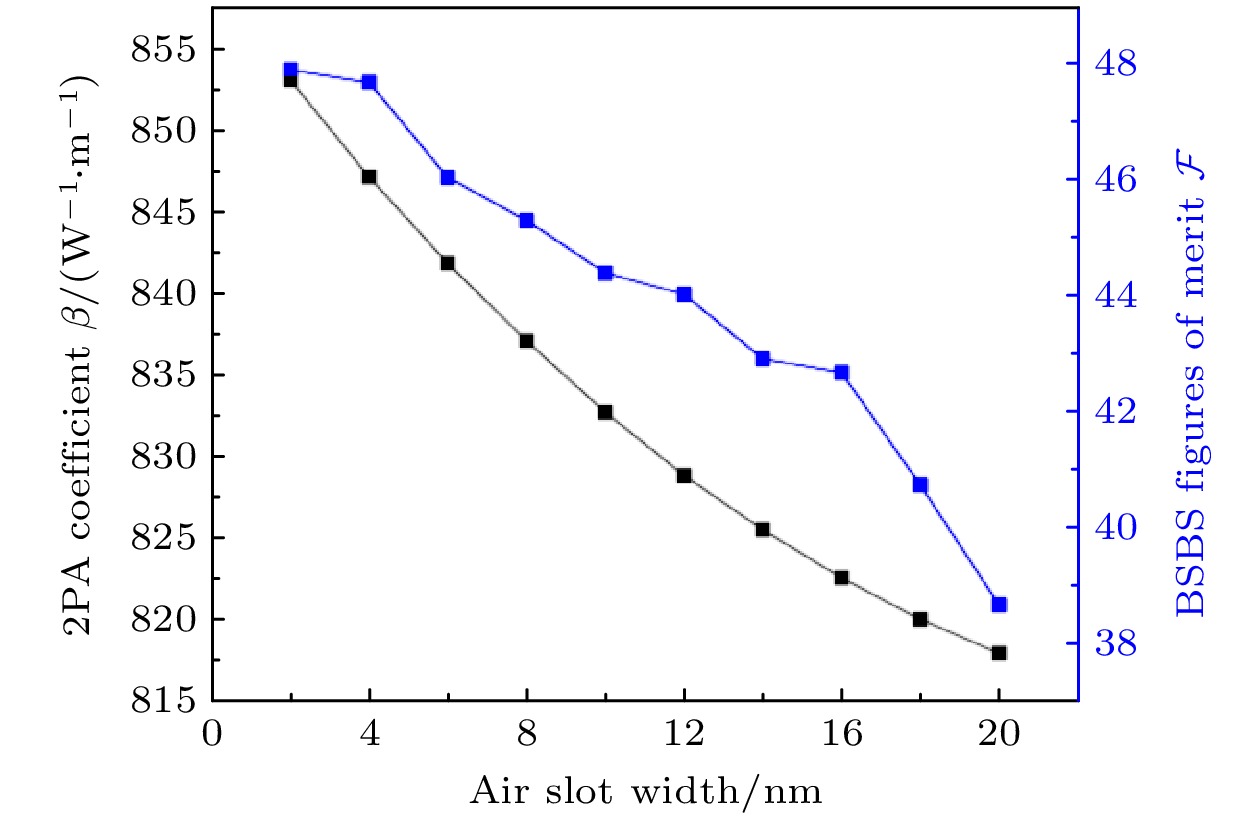-
受激布里渊散射效应具有光谱线宽窄、频率稳定和增益方向敏感等优点, 常用于激光器, 慢光产生和微波光子滤波器等. 本文基于As2S3硫系玻璃、以SiO2为衬底设计了一种亚微米尺寸的带空气狭缝倒置结构脊型波导结构, 具有高达8.22×104 W–1·m–1的后向受激布里渊散射增益系数. 研究显示在该结构的同种光学和声学模式下, 更小的声光场有效模场面积具有更高的后向受激布里渊散射增益系数. 还分析了硫系玻璃的光学损耗对后向受激布里渊散射的影响, 发现当波导长度超过最优值后, 斯托克斯光波功率开始下降, 而增大泵浦光功率不仅可以提高斯托克斯光波功率的极大值, 同时还会增大波导长度的最优值. 当所输入的泵浦光功率为20 mW时, 受激布里渊散射增益达到100 dB波导长度仅需要2 cm, 这非常有利于光子器件的片上集成.The stimulated Brillouin scattering (SBS) effect has the advantages of narrow spectral line width, frequency stability, and sensitivity to gain direction, which is commonly used in the field of integrated photonic devices, such as lasers, slow light generation and microwave photonic filters. In practical applications, due to the low gain coefficient of SBS in traditional chalcogenide waveguides, there are high threshold of pumping power and long waveguide length. In this work, an inverted-ridge waveguide structure with air slot is designed by adopting As2S3 and SiO2, which presents high backward stimulated Brillouin scattering (BSBS) gain coefficient. This chalcogenide inverted-ridge optical waveguide with air slot can better confine the optical field and acoustic field within the ridge region for improving the coupling efficiency between optical field and acoustic field. More significantly, adding an air slot into the ridge region of this chalcogenide waveguide will produce powerful radiation pressure at the boundary between the air slot and As2S3. Owing to the fact that the acoustic field is mainly distributed near the air slot in the ridge region, the coupling effect of the radiation pressure and acoustic field is significantly enhanced, leading to a significant increase in BSBS gain coefficient. In this work, the optical fundamental mode as optical mode due to the chalcogenide waveguide with submicron size structure and the six lowest order acoustic modes that meet the matching vector conditions as acoustic mode are calculated, and it is found that the fifth order acoustic mode achieves a maximum BSBS gain coefficient in the six acoustic modes. On this basis, by scanning the waveguide structural parameters of the air slot width, waveguide ridge width and height, and waveguide thickness, the BSBS gain coefficient is as high as 8.22×104 W–1·m–1, which is more than three times the currently reported chalcogenide waveguide with non-suspended structure. Additionally, the calculation results also indicate that this chalcogenide waveguide with a smaller effective mode field area has a higher BSBS gain coefficient in the same optical mode and acoustic mode, providing a new idea for further improving the BSBS gain coefficient in the design of waveguide structure. At the same time, the influence of optical loss on BSBS gain is also analyzed, and it is found that when the waveguide length exceeds the optimal value, the lost energy caused by the optical loss will be beyond the input energy of the pump optical wave, causing the power of the stokes optical wave to begin to decrease. However, the improvement of the power of pump optical wave not only increases the maximum power of the Stokes optical wave, but also raises the optimal value of the waveguide length. The results of simulation calculation show that when the input power of pump optical wave is about 20 mW, this chalcogenide waveguide with only 2 cm waveguide length has a BSBS gain of 100 dB, which has the advantages of low pumping power and short waveguide length in the currently reported on-chip integration of chalcogenide waveguides.
-
Keywords:
- stimulated Brillouin scattering /
- chalcogenide optical waveguide /
- effective mode field area /
- optical loss
[1] Dainese P, Rusell P, Joly N, Knight J, Wiederhecker G, Fragnito H, Laude V, Khelif A 2006 Nature Phys. 2 388
 Google Scholar
Google Scholar
[2] Zhu Z, Gauthier D J, Boyd R W 2007 Science 318 1748
 Google Scholar
Google Scholar
[3] Gundavarapu S, Brodnik G M, Puckett M, Huffman T, Bose D, Behunin R, Wu J, Qiu T, Pinho C, Chauhan C, Nohava J, Rakich P T, Nelson K D, Salit M, Blumenthal D J 2019 Nat. Photonics 13 60
 Google Scholar
Google Scholar
[4] Hu K, Yi L L, Wei W, Hu W S 2019 Chin. Opt. Lett. 17 060603
 Google Scholar
Google Scholar
[5] Sharma D K, Tripathi S M 2020 J. Non-Cryst. Solids 542 120114
 Google Scholar
Google Scholar
[6] Kobyakov A, Sauer M, Chowdhury D 2010 Adv. Opt. Photonics 2 1
 Google Scholar
Google Scholar
[7] Kittlaus E A, Shin H, Rakich P T 2016 Nat. Photonics 10 463
 Google Scholar
Google Scholar
[8] Diamandi H H, Zadok A 2019 Nat. Photonics 13 9
 Google Scholar
Google Scholar
[9] Deroh M, Kibler B, Lemiere A, Desevedavy F, Smektala F, Maillotte H, Sylvestre T, Beugnot J C 2019 Appl. Opt. 58 6365
 Google Scholar
Google Scholar
[10] Morrison B, Casas-Bedoya A, Ren G, Vu K, Liu Y, Zarifi A, Nguyen T G, Choi D Y, Marpaung D, Madden S J, Mitchell A, Eggleton B J 2017 Optica 4 847
 Google Scholar
Google Scholar
[11] Eggleton B J, Luther-Davies B, Richardson K 2011 Nat. Photonics 5 141
 Google Scholar
Google Scholar
[12] Laer R V, Kuyken B, Thourhout D V, Baets R 2014 Opt. Lett. 39 1242
 Google Scholar
Google Scholar
[13] Jouybari S N 2018 Photonics Nanostruct. Fudam. Appl. 29 8
 Google Scholar
Google Scholar
[14] Zhou L, Lu Y G, Fu Y Y, Ma H X, Du C L 2019 Opt. Express 27 24953
 Google Scholar
Google Scholar
[15] 王武越, 于宇, 李云飞, 王汞, 李凯, 王志永, 宋长禹, 李森森, 李宇海, 刘彤宇, 闫秀生, 王雨雷, 吕志伟 2022 物理学报 71 024203
 Google Scholar
Google Scholar
Wang W Y, Yu Y, Li Y F, Wang G, Li K, Wang Z Y, Song C Y, Li S S, Li Y H, Liu T Y, Yan X S, Wang Y L, Lü Z W 2022 Acta Phys. Sin. 71 024203
 Google Scholar
Google Scholar
[16] 齐人铎, 翟彦芬, 张巍, 黄翊东 2022 光子学报 51 0551303
 Google Scholar
Google Scholar
Qi R Z, Zhai Y F, Zhang W, Huang Y D 2022 Acta Photonica Sin. 51 0551303
 Google Scholar
Google Scholar
[17] Qiu W J, Rakich P T, Shin H, Dong H, Soljačić M, Wang Z 2013 Opt. Express 21 31402
 Google Scholar
Google Scholar
[18] Agrawal G P 2005 Nonlinear Fiber Optics 18 1
[19] Byrnes A, Pant R, Li R, Choi D Y, Poulton C G, Fan S, Madden S, Luther-Davies B, Eggleton B J 2012 Opt. Express 20 18836
 Google Scholar
Google Scholar
[20] Wolff C, Gutsche P, Steel M J, Eggleton B J, Poulton C G 2015 J. Opt. Soc. Am. B: Opt. Phys. 32 1968
 Google Scholar
Google Scholar
[21] Mirnaziry S R, Wolff C, Steel M J, Eggleton B J, Poulton C G 2016 Opt. Express 24 4786
 Google Scholar
Google Scholar
[22] Rakich P T, Davids P, Wang Z 2010 Opt. Express 18 14439
 Google Scholar
Google Scholar
[23] Eggleton B J, Poulton C G, Pant R 2013 Adv. Opt. Photonics 5 536
 Google Scholar
Google Scholar
[24] Zou L E, Wang G R, Shen Y, Chen B X, Mamoru I 2011 J. Semicond. 32 112004
 Google Scholar
Google Scholar
[25] 任国斌, 王智, 娄淑琴, 简水生 2004 电子学报 32 5
 Google Scholar
Google Scholar
Ren G B, Wang Z, Lou S Q, Jian S S 2004 Acta Electronica Sin. 32 5
 Google Scholar
Google Scholar
[26] Wolff C, Steel M J, Eggleton B J, Poulton C G 2015 Phys. Rev. A 92 013836
 Google Scholar
Google Scholar
[27] Choudhary A, Morrison B, Aryanfar I, Shahnia S, Pagani M, Liu Y, Vu K, Madden S, Marpaung D, Eggleton B J 2017 J. Lightwave Technol. 35 846
 Google Scholar
Google Scholar
-
图 2 带空气狭缝倒置结构的硫系脊型波导的光场和声场分布 (a) 工作波长1550 nm下光场基模$ {E_x} $, $ {E_y} $和$ {E_z} $的场分布; (b) 满足波矢匹配条件的最低一至六阶(A1—A6)声场模式$ {u_x} $, $ {u_y} $和$ {u_z} $的场分布
Fig. 2. Optical and acoustic field distribution of chalcogenide inverted-ridge optical waveguide with air slot: (a) Fundamental optical mode $ {E_x} $, $ {E_y} $and $ {E_z} $ at 1550 nm wavelength; (b) lowest first to sixth order (A1–A6) acoustic field modes $ {u_x} $, $ {u_y} $ and $ {u_z} $ which meet the wave vector matching conditions.
图 3 倒置结构硫系脊型波导光场基模与满足波矢匹配条件的最低一至六阶声学模式的耦合分别在光辐射压力、电致伸缩力作用下的BSBS增益系数, 以及在这两个力共同作用下的总BSBS增益系数 (a) 带空气狭缝; (b) 不带空气狭缝
Fig. 3. BSBS gain coefficient by the coupling between the optical field fundamental mode and the lowest first to sixth order acoustic mode which satisfies the wave vector matching condition under the effect of radiation pressure, electrostriction force, and the combined effect of them in chalcogenide inverted-ridge optical waveguide with air slot, respectively: (a) With air slot; (b) without air slot.
图 4 (a) A5声场模式下, BSBS总增益系数随空气狭缝宽度d变化的关系; (b) $ {C_{{\text{FV}}m}} $, $ {C_{{\text{EF}}m}} $和$ Q_{{\mathrm{c}}m}^2 $归一化系数随空气狭缝宽度变化的关系
Fig. 4. (a) BSBS total gain coefficient as air slot width d varied in A5 acoustic field mode; (b) $ {C_{{\text{FV}}m}} $, $ {C_{{\text{EF}}m}} $ and $ Q_{{\mathrm{c}}m}^2 $ normalization coefficient as air slot width d varied.
图 6 脊高a与脊宽b同时变化时的范围为900—920 nm(a) BSBS总增益系数的分布; (b) 声场与光场有效模场面积之积的倒数分布
Fig. 6. Range when the ridge height a and width b change simultaneously is 900–920 nm: (a) Distribution of the BSSB total gain coefficient; (b) distribution of the reciprocal that product of the effective mode field area of acoustic and optical field.
图 7 BSBS总增益系数与声光场有效模场面积之积的倒数随波导厚度e变化关系. 波导尺寸为a = 910 nm, b = 902 nm, c = 100 nm, d = 4 nm
Fig. 7. BSBS total gain coefficient and reciprocal which the product of effective mode field area of the acoustic field and the optical field varied with waveguide thickness e. The size of the waveguide structure: a = 910 nm, b = 902 nm, c = 100 nm, d = 4 nm.
图 9 (a) 不同泵浦光功率下斯托克斯放大与波导长度间的变化关系; (b) 波导长度最优值与泵浦光功率间的变化关系. 波导结构参数为a = 910 nm, b = 902 nm, c = 100 nm, d = 4 nm, e = 250 nm
Fig. 9. (a) The Stokes amplification varied with the waveguide length under the different pump optical wave power; (b) optimal value of waveguide length varied with pump optical wave power. The size of the waveguide structure: a = 910 nm, b = 902 nm, c = 100 nm, d = 4 nm, e = 250 nm
表 1 最低一至六阶(A1—A6)声学模式的参数$ {D_x} $归一化值与BSBS总增益系数
Table 1. Normalized values of parameter $ {D_x} $and BSBS total gain coefficients for the lowest first to sixth order (A1–A6) acoustic modes.
A1 A2 A3 A4 A5 A6 BSBS总增益系数/(104 W–1·m–1) 1.06 0.39 0.61 0.62 2.69 0.74 $ {D_x} $ 0.576 0.026 0.343 0.345 1.000 0.359 -
[1] Dainese P, Rusell P, Joly N, Knight J, Wiederhecker G, Fragnito H, Laude V, Khelif A 2006 Nature Phys. 2 388
 Google Scholar
Google Scholar
[2] Zhu Z, Gauthier D J, Boyd R W 2007 Science 318 1748
 Google Scholar
Google Scholar
[3] Gundavarapu S, Brodnik G M, Puckett M, Huffman T, Bose D, Behunin R, Wu J, Qiu T, Pinho C, Chauhan C, Nohava J, Rakich P T, Nelson K D, Salit M, Blumenthal D J 2019 Nat. Photonics 13 60
 Google Scholar
Google Scholar
[4] Hu K, Yi L L, Wei W, Hu W S 2019 Chin. Opt. Lett. 17 060603
 Google Scholar
Google Scholar
[5] Sharma D K, Tripathi S M 2020 J. Non-Cryst. Solids 542 120114
 Google Scholar
Google Scholar
[6] Kobyakov A, Sauer M, Chowdhury D 2010 Adv. Opt. Photonics 2 1
 Google Scholar
Google Scholar
[7] Kittlaus E A, Shin H, Rakich P T 2016 Nat. Photonics 10 463
 Google Scholar
Google Scholar
[8] Diamandi H H, Zadok A 2019 Nat. Photonics 13 9
 Google Scholar
Google Scholar
[9] Deroh M, Kibler B, Lemiere A, Desevedavy F, Smektala F, Maillotte H, Sylvestre T, Beugnot J C 2019 Appl. Opt. 58 6365
 Google Scholar
Google Scholar
[10] Morrison B, Casas-Bedoya A, Ren G, Vu K, Liu Y, Zarifi A, Nguyen T G, Choi D Y, Marpaung D, Madden S J, Mitchell A, Eggleton B J 2017 Optica 4 847
 Google Scholar
Google Scholar
[11] Eggleton B J, Luther-Davies B, Richardson K 2011 Nat. Photonics 5 141
 Google Scholar
Google Scholar
[12] Laer R V, Kuyken B, Thourhout D V, Baets R 2014 Opt. Lett. 39 1242
 Google Scholar
Google Scholar
[13] Jouybari S N 2018 Photonics Nanostruct. Fudam. Appl. 29 8
 Google Scholar
Google Scholar
[14] Zhou L, Lu Y G, Fu Y Y, Ma H X, Du C L 2019 Opt. Express 27 24953
 Google Scholar
Google Scholar
[15] 王武越, 于宇, 李云飞, 王汞, 李凯, 王志永, 宋长禹, 李森森, 李宇海, 刘彤宇, 闫秀生, 王雨雷, 吕志伟 2022 物理学报 71 024203
 Google Scholar
Google Scholar
Wang W Y, Yu Y, Li Y F, Wang G, Li K, Wang Z Y, Song C Y, Li S S, Li Y H, Liu T Y, Yan X S, Wang Y L, Lü Z W 2022 Acta Phys. Sin. 71 024203
 Google Scholar
Google Scholar
[16] 齐人铎, 翟彦芬, 张巍, 黄翊东 2022 光子学报 51 0551303
 Google Scholar
Google Scholar
Qi R Z, Zhai Y F, Zhang W, Huang Y D 2022 Acta Photonica Sin. 51 0551303
 Google Scholar
Google Scholar
[17] Qiu W J, Rakich P T, Shin H, Dong H, Soljačić M, Wang Z 2013 Opt. Express 21 31402
 Google Scholar
Google Scholar
[18] Agrawal G P 2005 Nonlinear Fiber Optics 18 1
[19] Byrnes A, Pant R, Li R, Choi D Y, Poulton C G, Fan S, Madden S, Luther-Davies B, Eggleton B J 2012 Opt. Express 20 18836
 Google Scholar
Google Scholar
[20] Wolff C, Gutsche P, Steel M J, Eggleton B J, Poulton C G 2015 J. Opt. Soc. Am. B: Opt. Phys. 32 1968
 Google Scholar
Google Scholar
[21] Mirnaziry S R, Wolff C, Steel M J, Eggleton B J, Poulton C G 2016 Opt. Express 24 4786
 Google Scholar
Google Scholar
[22] Rakich P T, Davids P, Wang Z 2010 Opt. Express 18 14439
 Google Scholar
Google Scholar
[23] Eggleton B J, Poulton C G, Pant R 2013 Adv. Opt. Photonics 5 536
 Google Scholar
Google Scholar
[24] Zou L E, Wang G R, Shen Y, Chen B X, Mamoru I 2011 J. Semicond. 32 112004
 Google Scholar
Google Scholar
[25] 任国斌, 王智, 娄淑琴, 简水生 2004 电子学报 32 5
 Google Scholar
Google Scholar
Ren G B, Wang Z, Lou S Q, Jian S S 2004 Acta Electronica Sin. 32 5
 Google Scholar
Google Scholar
[26] Wolff C, Steel M J, Eggleton B J, Poulton C G 2015 Phys. Rev. A 92 013836
 Google Scholar
Google Scholar
[27] Choudhary A, Morrison B, Aryanfar I, Shahnia S, Pagani M, Liu Y, Vu K, Madden S, Marpaung D, Eggleton B J 2017 J. Lightwave Technol. 35 846
 Google Scholar
Google Scholar
计量
- 文章访问数: 1197
- PDF下载量: 32
- 被引次数: 0














 下载:
下载:








